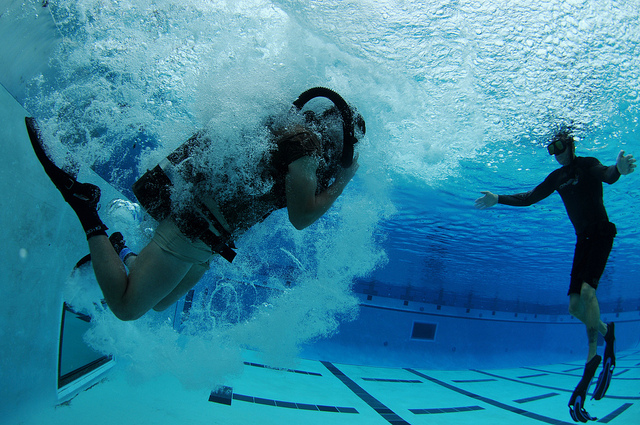We all have fears. It is part of the reality of being human. Those who deny having any fears typically are lying or are not being honest with themselves.
The following comments are based on my work and research with athletes, business people and other elite performers such as Special Forces members. Further resources for information on this topic include many articles, books, audio and video works, including the 2009 History Channel documentary called The Brain. The GAMES Approach mentioned below is adapted from a Navy SEAL approach to dealing with fears, which was covered in the History Channel’s The Brain documentary.
Can fears get in the way of accomplishing your objectives? Can they keep you from becoming great at whatever it is you want to conquer? Absolutely! Fears can stop you dead in your tracks, quite literally. This is due to how the brain functions and sometimes this reality works to your benefit, particularly in the area of physical safety.
However, in the area of “mental safety,” fear can be a real problem. In the brain’s desire to protect you from the unknown and apparently dangerous, it can actually impede you from accomplishing your most important goals.
Rather than focus in depth on the physiological realities that cause you to stop “dead in your tracks,” I’ll give you a basic primer on what happens in your brain when confronted with “scary” situations, then we’ll quickly move on to what you can do about it, so that you can, to quote the Doors, “break on through to the other side”.
When you are confronted with a scary situation, in basic terms, your brain presses the “panic button”. The danger is perceived by your senses then makes it way over to the Amygdala, one of the regions of the brain that deals with emotion, where if the danger is perceived to be real and imminent, the brain starts a cascade effect of panic responses. Your heart beats faster, you breathe faster, your blood pressure rises, and if the level of panic is sufficient, chemicals such as adrenaline and cortisol are released into your bloodstream. The fight or flight system is thus activated and you’re in full panic mode, like it or not.
Unless the Frontal Lobes of the Cerebral Cortex can get the Amygdala’s panic cascade under control, or prevent it from occurring in the first place, the likelihood of pushing through your fears is quite limited. The Nervous System response and blood stream chemical effects are simply overwhelming. The problem is that research has shown that the sensory data arrives more quickly to the Amygdala than it does to the Frontal Lobes, where rational thought could potentially prevent the fear reaction from cascading out of control. Then how can the Frontal Lobes possibly prevent the Amygdala from reacting and triggering panic mode? Per The Brain documentary mentioned above, this was a question very much on the mind of instructors at the Navy SEALs Special Warfare Command in San Diego, California.
They came to the realization that they were losing a large number of potential SEALs from the training process due to one simple fact: they could not control their fear response.

This inability to control the fear response was most apparent in what’s called the Underwater Pool Competency Test. This is the test where SEAL candidates spend as much as 20 minutes underwater with SCUBA equipment, during which time they are constantly harassed by instructors. The instructors will turn off their regulators, tie their breathing gear into knots and generally make it difficult to breathe from the SCUBA tank for more than a short time. This harassment leads to a steadily worsening mental and physical condition and the candidates must do everything they can to resist the desire to surface for air. It is an incredibly strong desire that is extraordinarily difficult to suppress. The human brain has been hardwired to understand that breathing is absolutely fundamental, that we cannot breathe underwater, and without oxygen for any prolonged period, we’re dead.
So realizing that the Amygdala pushes the panic button, and further realizing that the only way to overcome this automatic response would be to get the Cortex/ Frontal Lobes involved, the SEAL commanders came to the conclusion that it was important to be pro-active and condition a “non-panic” response by repeated exposure to the “right” emergency procedures. What it boils down to is that the Cortex / Frontal Lobes cannot get involved “realtime” before the Amygdala at the moment the danger is perceived, as they receive the sensory input more slowly, so the response needs to be conditioned based on practice before any event that could induce panic. The candidates need to override their panic system, based on previously obtained and internalized knowledge and a set of step-by-step procedures and techniques. While there are more, SEAL instructors decided to focus on what they call the “big 4” techniques: Goal-setting; Mental Rehearsal; Self-talk; and Arousal Control. I have added a fifth, “Endurance,” and re-orderded them a bit to come up with the “GAMES” Approach to conquering your fears. Next we will touch on each of the elements of the GAMES Approach.
[G]oal-setting: This involves creating very short-term and achievable goals, so that you are not overwhelmed by a bunch of extraneous thoughts and concerns and can remain focused on the task at hand. So, for example in the case of the Underwater Pool Competency Test, when you were underwater and the instructor tangled your breathing apparatus, you wouldn’t think to yourself, “I wonder what he’s going to do to me next…”, or “I’m not sure how much more of this I can take…”, or “I wonder how the candidate next to me is doing…”. Rather, you would say to yourself, simply, my goal is to untangle these knots – nothing more and nothing less. You would then say to yourself: I will employ the knot untangling procedure we learned in training step-by-step. Then you would execute step one, step two … etc. In other words, you would block out all extraneous thoughts and factors and focus totally on the task at hand, step-by-step. Can you see how you could use the same approach with any fears you may have in business, sports or life?
[A]rousal Control: This element focuses mainly on breathing. Taking deeper breaths with longer exhales stimulates the body’s relaxation response and helps to mitigate some of the effects that the Amygdala’s panic response can create. So, in the Pool Competency example, when the instructor tied your hoses or pulled your mask off, rather than immediately starting to try to breathe rapidly (which you couldn’t anyway if what the instructor interrupted the air supply), you would calm your mind with a decent exhale and then calmly get to work on accomplishing your goals and following procedures to address the issue, step-by-step. The relaxed breathing is harder to do in this example underwater, but can you see how breathing in a more relaxed fashion in business, sports or the rest of your life, and remaining calm rather than immediately going into panic mode, could help your performance?
[M]ental Rehearsal: Often referred to as visualization, mental rehearsal involves running through in your mind whatever it is that you are trying to accomplish, envisioning all the steps, then reacting calmly to any stress and ultimately, achieving a successful outcome. Mental rehearsal is seeing yourself doing it over and over again successfully, as if in a movie. You can visualize the scenario from a first-person perspective, where you are seeing it through your eyes as you perform the actions, or from a third-person perspective, where it’s as if you are seeing it through the eyes of someone else who is watching you perform the task successfully. You should visualize the scenario in as much detail as possible, so it looks and feels as realistic as possible. There is a great deal of research out there that indicates that your mind has a hard time differentiating between a scenario vividly visualized and one that actually occurred. As one SEAL psychologist says, by performing this step of mental rehearsal, the first time you do something “in real life,” as far as your mind is concerned, it won’t be like the first time at all and you may have greater success controlling the panic reaction that typically would occur. The process of mental rehearsal has been of great assistance in enhancing SEAL performance; can you also see how doing this could help you perform better in all of your endeavors?
[E]ndurance: This element is a recognition that this pro-active approach to mastering the fear response is not something that will happen quickly. It is a war of attrition against your Amygdala’s fear response. You will have to have a great deal of endurance and determination as you do as many iterations as necessary to conquer your fear response(s) in your particular endeavor. You will need to commit to stay at it as long as necessary, bravely confronting and conquering your fears head-on, knowing that by doing so, you will greatly increase the probability of achieving greatness in your chosen endeavor. Your mantra should be: As long as it takes, as many times as it takes. It’s a marathon not a sprint. Commit ahead of time. Be brave. Do not give up until you conquer your fears and reach your objectives.
[S]elf-talk: As has been discussed and proven in many other contexts, the Navy SEAL commanders came to the realization that in becoming an effective Special Forces team member, what you say to yourself, particularly in times of stress, is very important. You can say as many as 1,000 words to yourself in a minute, but at a minimum, you are likely to say several hundred words. If you are filling your mind with negative thoughts, you don’t increase your chances of success; instead, you increase your probability of failure. Discipline yourself to focus on positive self-talk. Repeat encouraging phrases to yourself. Find specific phrases or words that are particularly calming for you, or particularly motivating for you. Use them constantly to prepare for scenarios and use them during scenarios that occur, in the “heat of the battle”. Be your own best fan. Be your own cheering section. Prove by your self-talk that you believe in yourself and in the probability that you will succeed. This will help you keep the stress response under control and it will help you succeed in every aspect of your life.
So there you have in a nutshell the GAMES Approach to overcoming fears and achieving your goals and “greatness” in all areas of your life. Don’t limit yourself to one or two of the elements of the Approach; use all five. Use them pro-actively and use them together, in concert. Some fear responses are so strong that they will overwhelm anything but a coordinated effort to make sure that your rational Cortex wins out over your emotional, panic-prone Amygdala. In the effort to control the fear response and increase the probability that you will accomplish your objectives and become great in your chosen endeavor, you need all the reinforcements and coordination you can get.




Thank you for this great post. Your advice is applicable to many areas of life outside the business world. I like your use of self-talking – it’s so easy to try to communicate well with other people and forget to take control of our own thoughts. I wrote recently on my own blog about the negative words we use eg “don’t look down’ and the importance of replacing these with positive ideas: “fix your eyes on the point you want to reach.”
I’ll be back to your site for more!
Thanks for your thoughts, Frances — much appreciated. I could not agree with you more that it’s very easy to get so focused on communicating well with others that we forget to communicate well with ourselves! Also, I took a look at your blog (https://www.speechcontacts.blogspot.com/) and found it very interesting. I’ve signed up to receive your updates. It’s of particular interest to me, as I see you do a lot of work with kids. All of our kids have had brief, early periods of stuttering, which they’ve all overcome. We weren’t sure what to attribute it to, but we got the sense it had to do with learning multiple languages simultaneously — my wife is Dutch and speaks to them in Dutch. Thanks again for your thoughts. I look forward to staying in touch. Paul
Great site. A lot of useful information here. I’m sending it to some friends!
Great! Sounds good. Happy to hear that you have found it useful. Paul
Valuable info. Lucky me I found your site by accident, I bookmarked it.
I just found your superb site and I have to tell you how much I appreciate what you have outlined. I hope to again and find something else I like.
Thanks for your comment, Vicki. I’m happy you found the approach useful. Paul
I think this is among the most vital information for me. And i am glad reading your article. But should remark on few general things, The web site style is wonderful, the articles is really nice : D. Good job, cheers